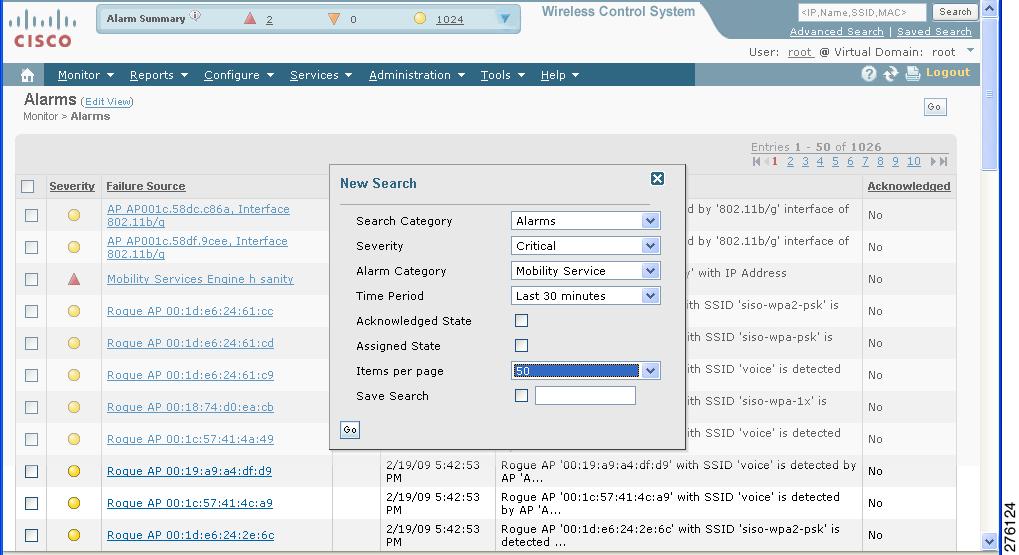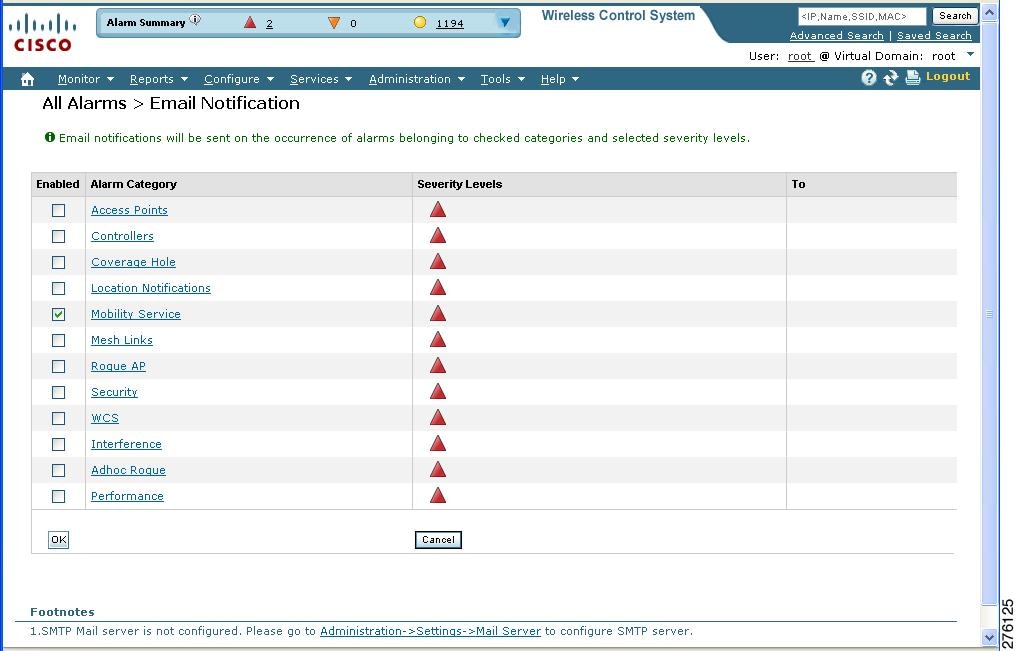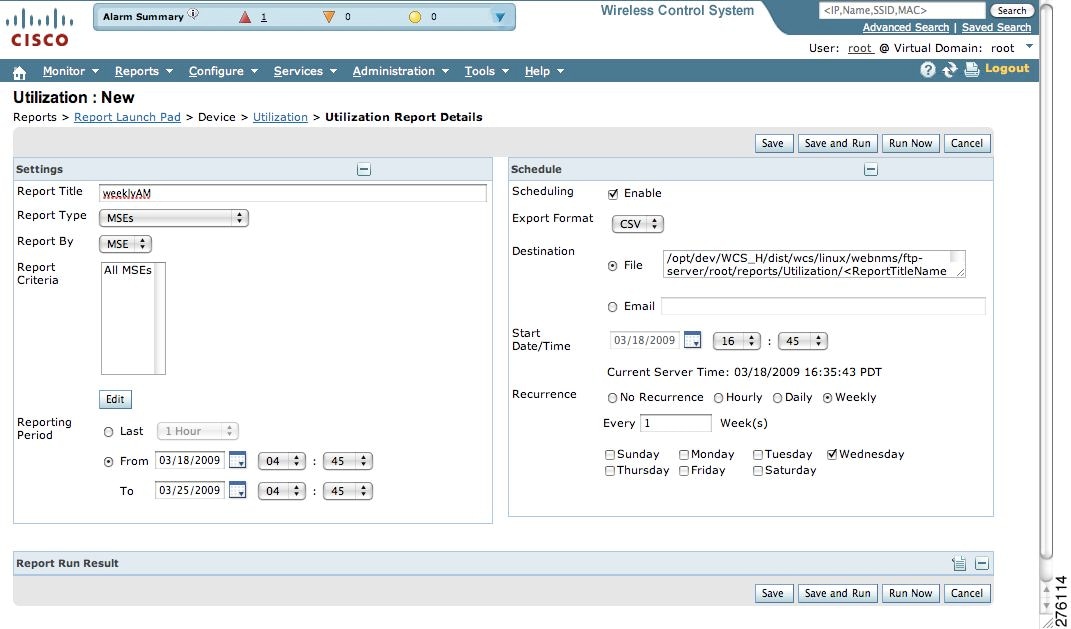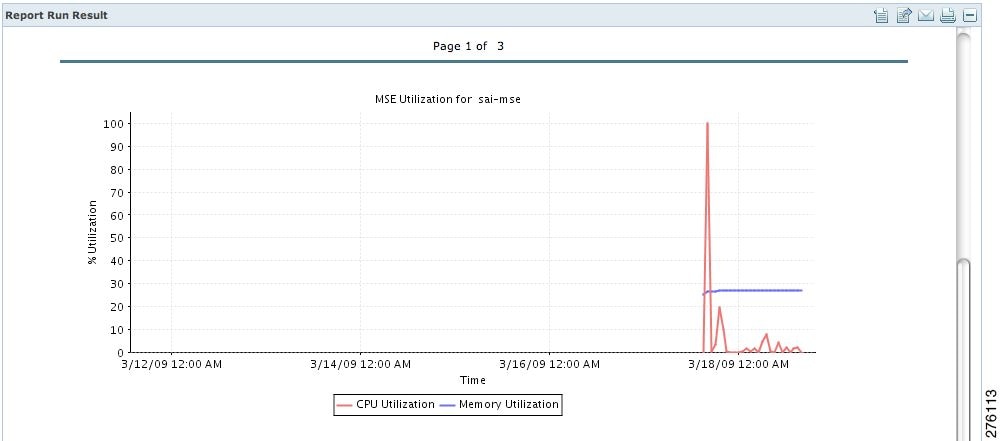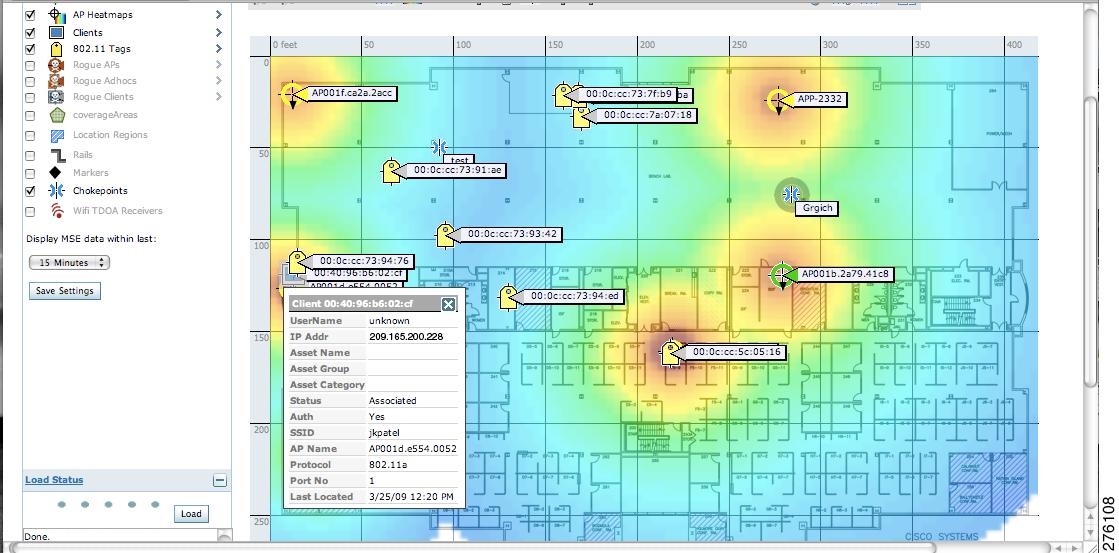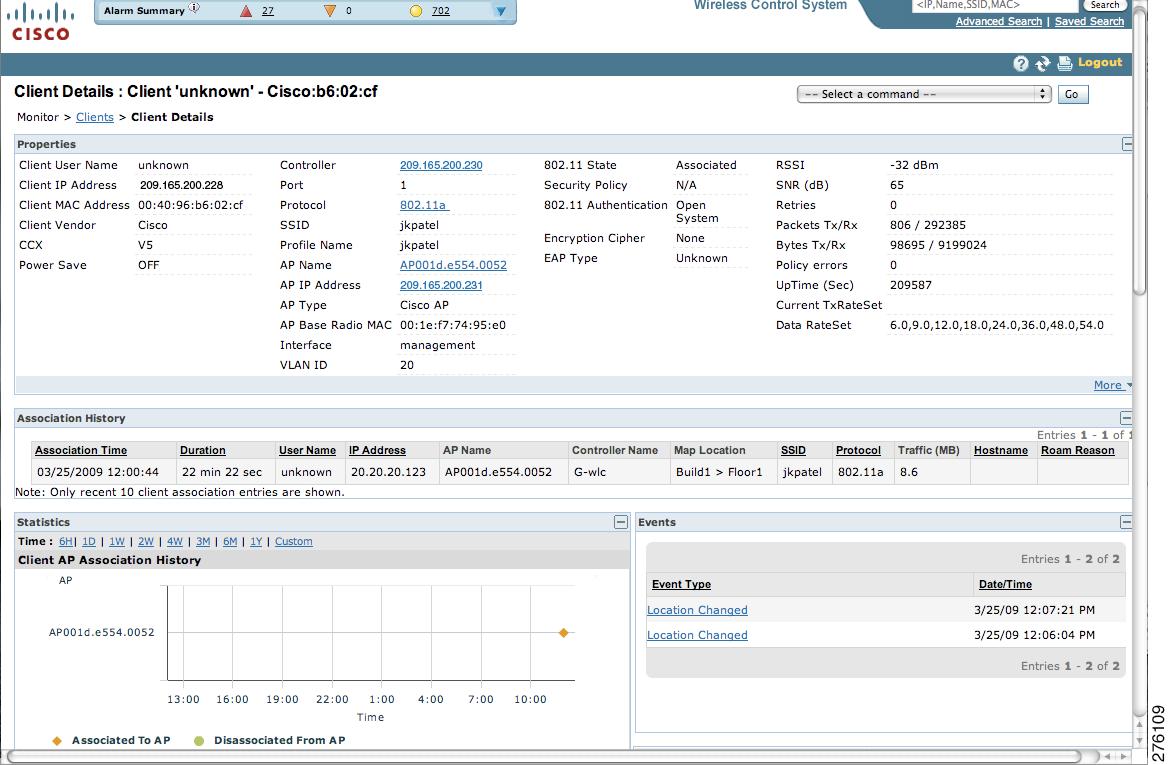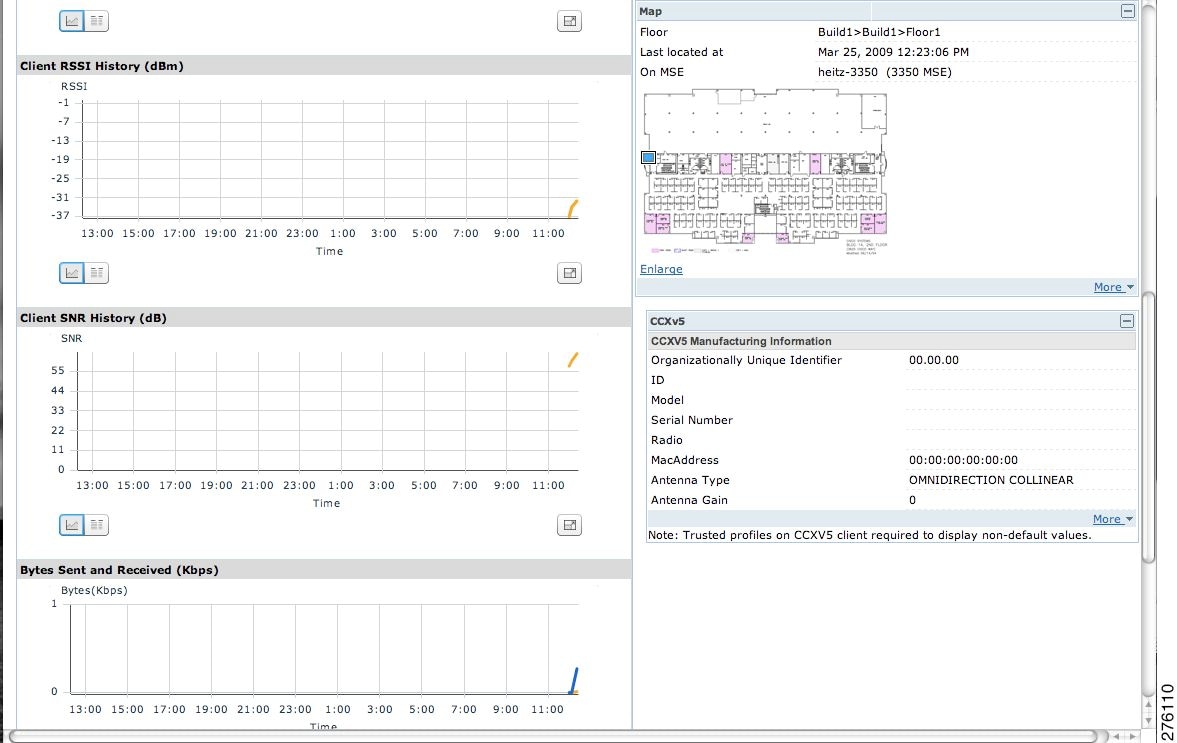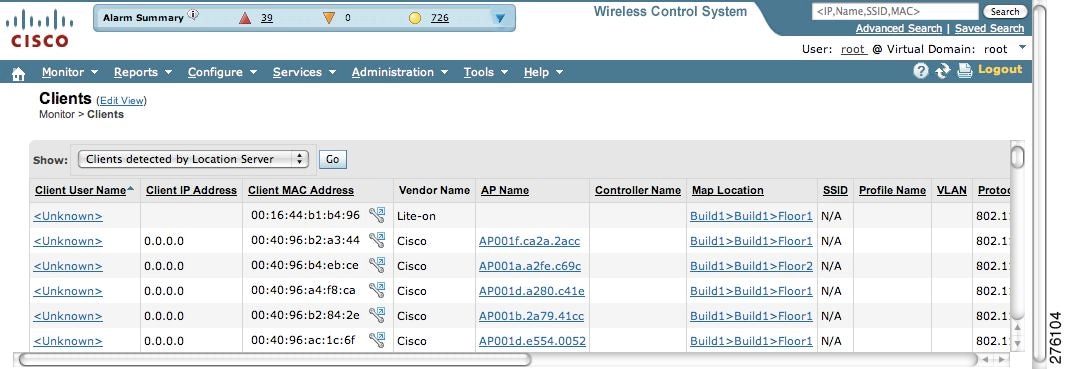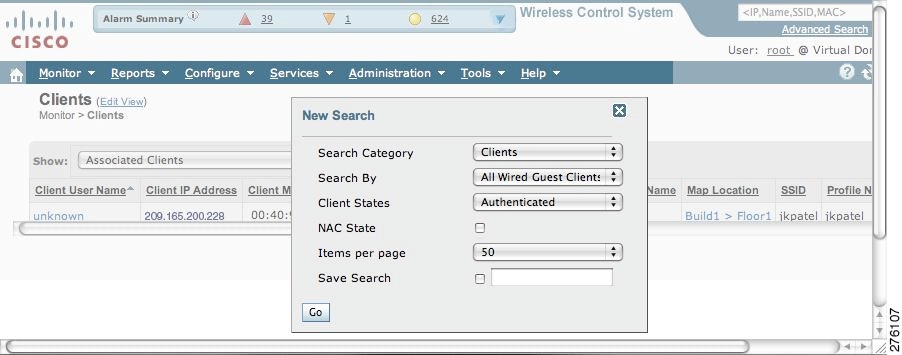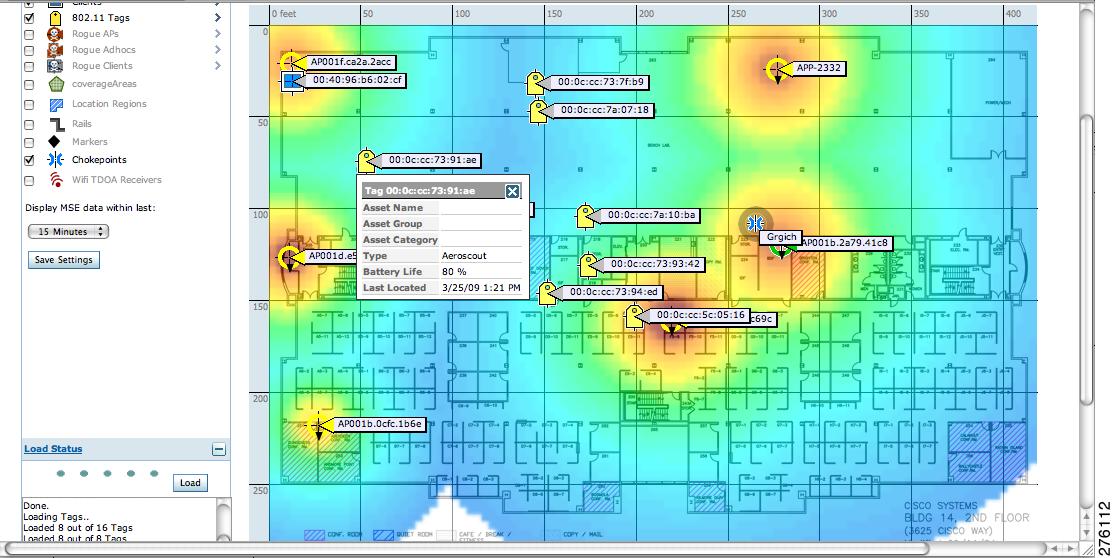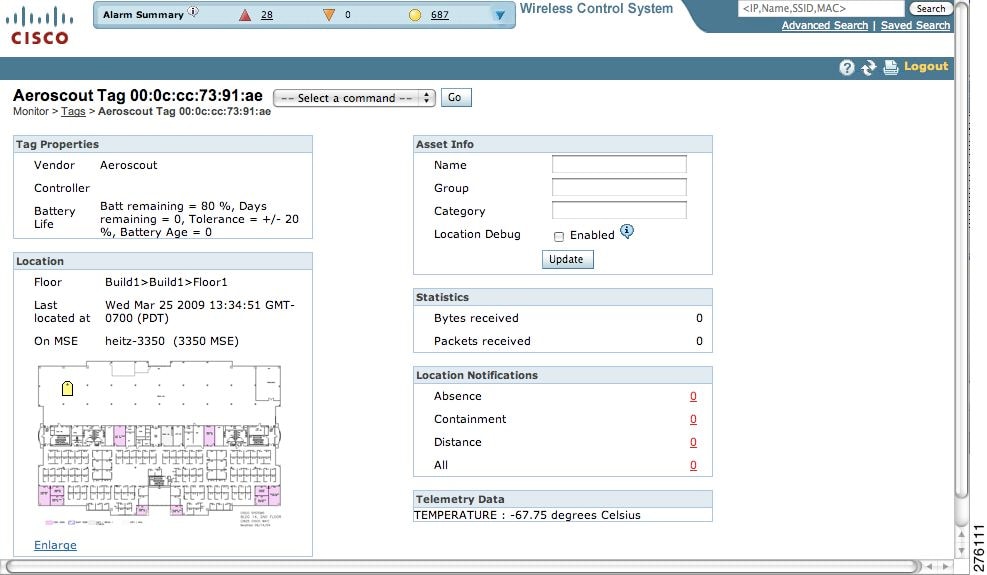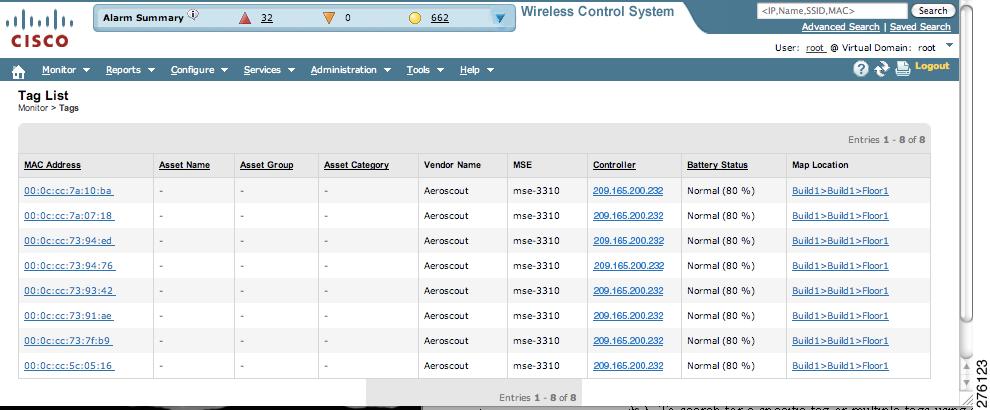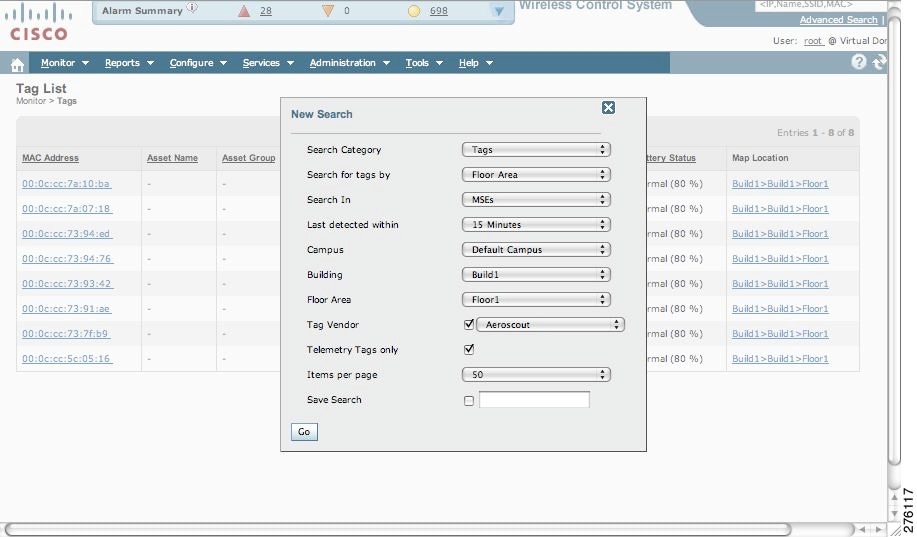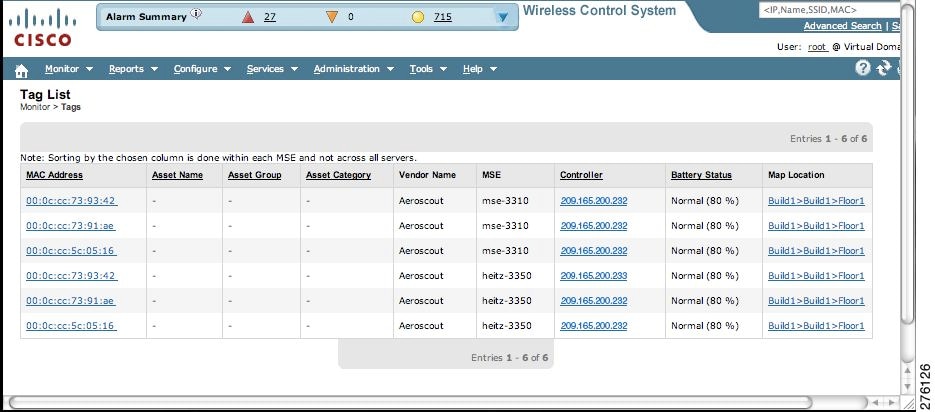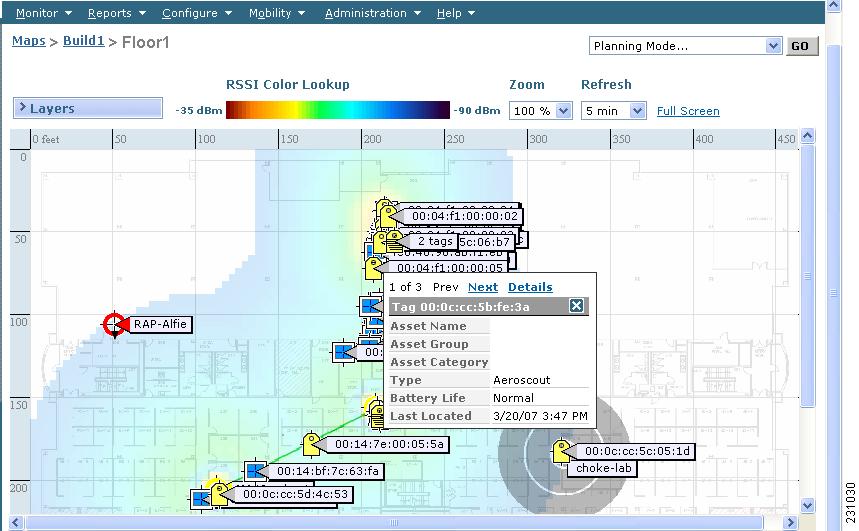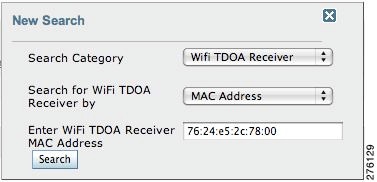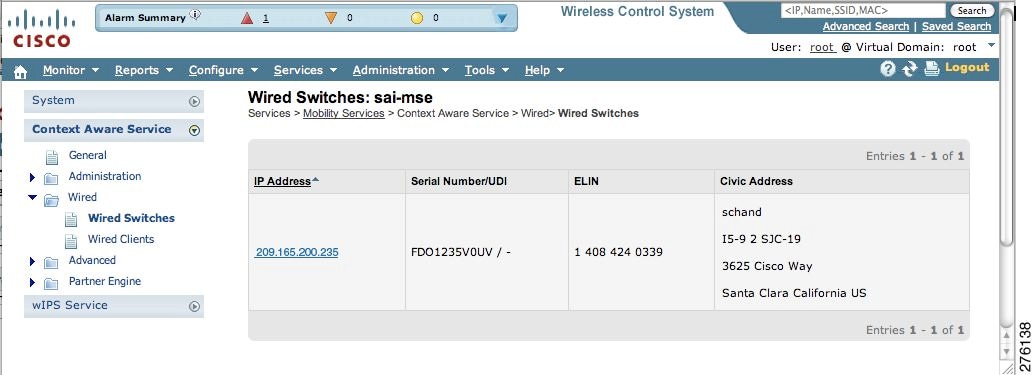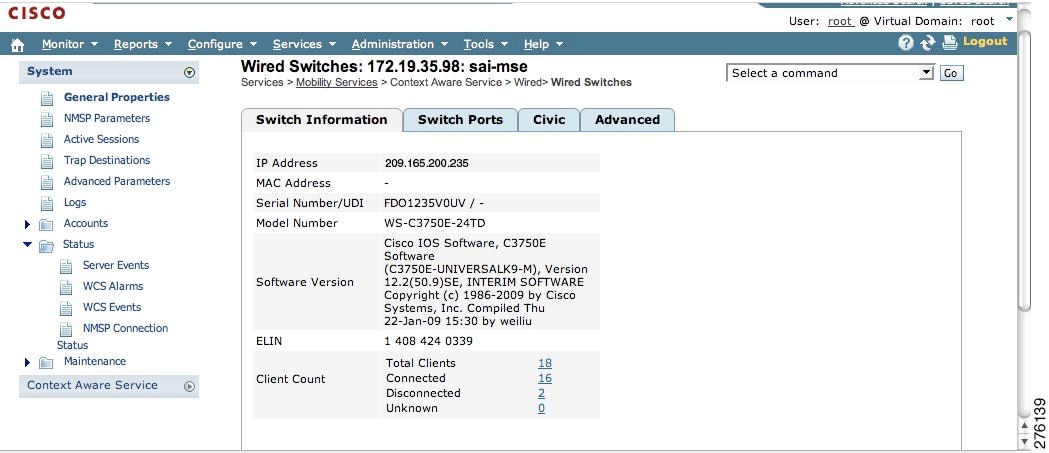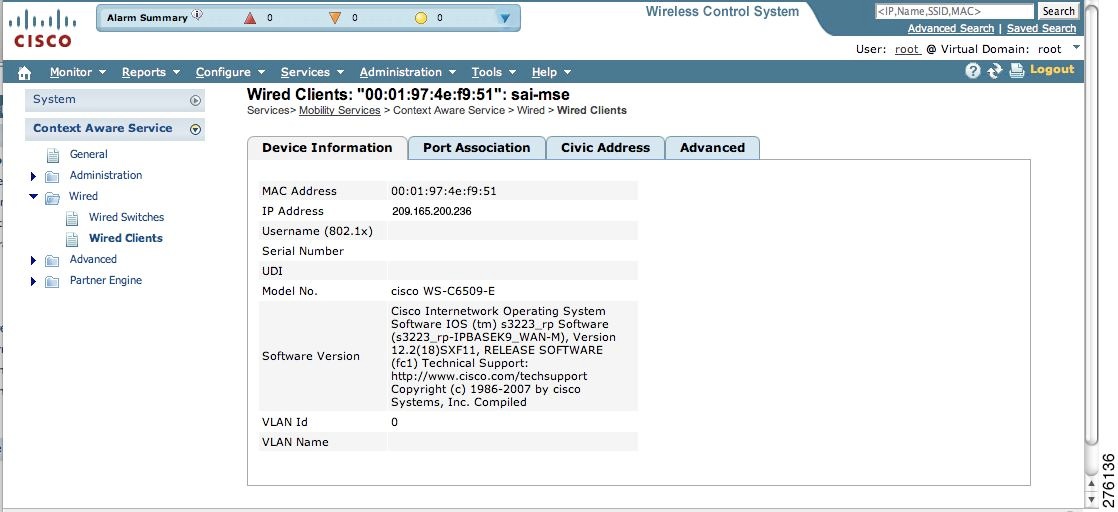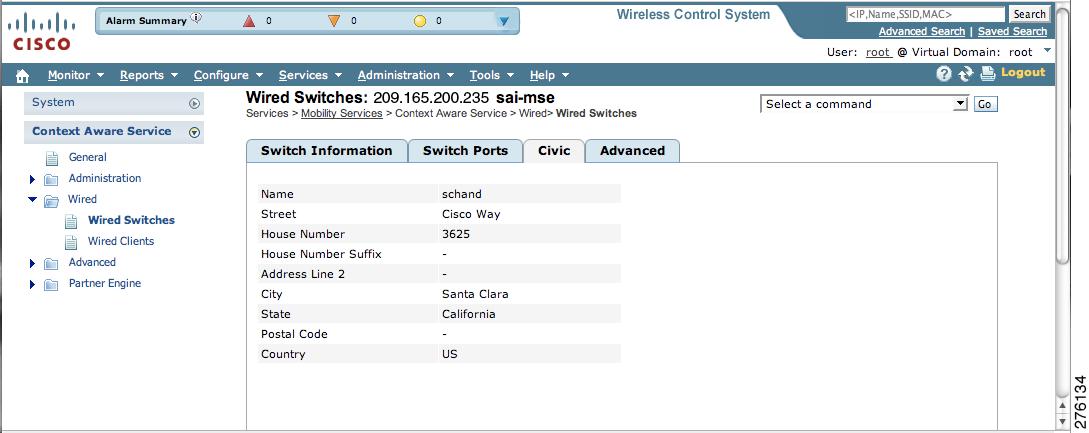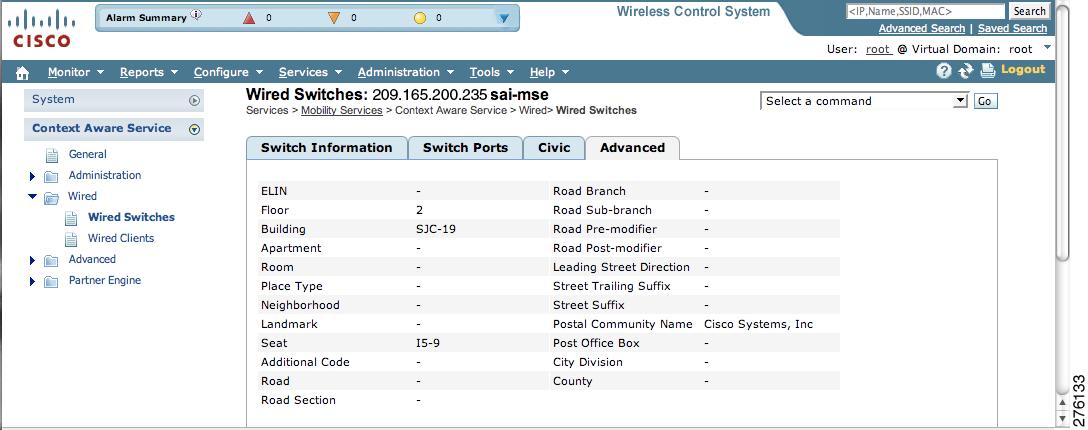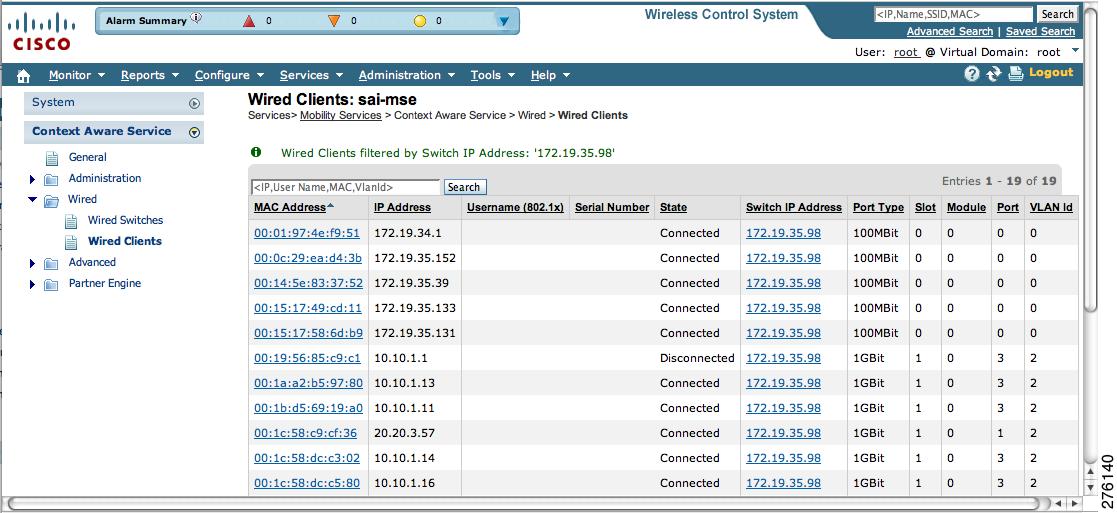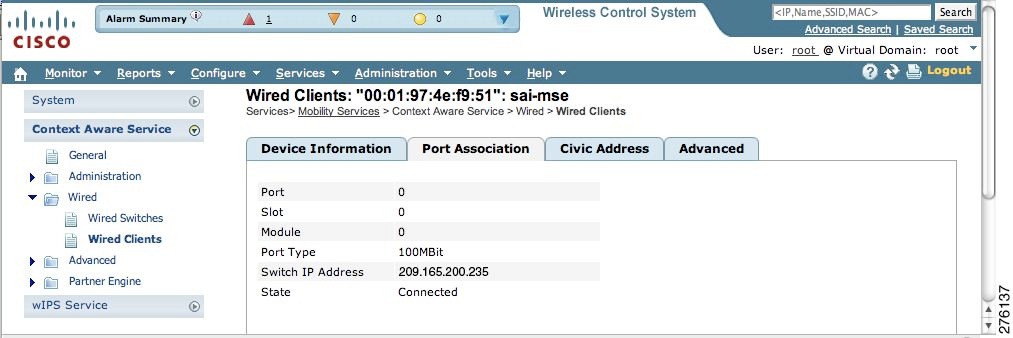

Table Of Contents
Monitoring the System and Services
Assigning and Unassigning Alarms
Creating a Device Utilization Report
Viewing Saved Utilization Reports
Viewing Scheduled Utilization Runs
Monitoring Wireless Clients Using Maps
Monitoring Wireless Clients Using Search
Monitoring Wi-Fi TDOA Receivers
Monitoring the System and Services
This chapter describes how to monitor the mobility services engine by configuring and viewing alarms, events, and logs as well as how to generate reports on system use and element counts (tags, clients, rogue clients, and access points).
It also describes how to use Cisco WCS to monitor clients (wired and wireless), tags, chokepoints, and Wi-Fi TDOA receivers.
This chapter contains the following sections:
•
Monitoring Wi-Fi TDOA Receivers
Working with Alarms
This section describes how to view, assign, and clear alarms and events on a mobility services engine using Cisco WCS. It also describes how to define alarm notifications (all, critical, major, minor, warning) and detail how to email those alarm notifications.
Viewing Alarms
To view mobility services engine alarms, follow these steps:
Step 1
In Cisco WCS, choose Monitor > Alarms.
Step 2
Click the Advanced Search link in the navigation bar (top-right). A configurable search panel for alarms appears (see Figure 8-1).
Figure 8-1 Advanced Search Alarm Panel
Step 3
Select Alarms as the Search Category.
Step 4
Select the Severity of Alarms to display. Options are All Severities, Critical, Major, Minor, Warning or Clear.
Step 5
Select Mobility Service from the Alarm Category.
Step 6
Select the time frame for which you want to review alarms from the Time Period drop-down menu.
Options range from minutes (5, 15, and 30) to hours (1 and 8) to days (1 and 7). To display all, select Any time.
Step 7
Check the Acknowledged State check box to exclude the acknowledged alarms and their count from the Alarm Summary window.
Step 8
Check the Assigned State check box to exclude the assigned alarms and their count from the Alarm Summary window.
Step 9
Select the number of alarms to display on each window from the Items per page drop-down menu.
Step 10
To save the search criteria for later use, check the Save Search box and enter a name for the search.
Note
You can initiate the search thereafter, by clicking the Saved Searches link at the top-right of the navigation bar.
Step 11
Click Go. The alarms summary panel appears with search results.
Note
Click the column headings (Severity, Failure Source, Owner, Date/Time, Message, and Acknowledged) to sort alarms.
Step 12
Repeat Step 2 to Step 11 to see Context-Aware notifications for the mobility services engine. Enter Context Aware Notifications as the alarm category in Step 5.
Assigning and Unassigning Alarms
To assign and unassign an alarm to yourself, follow these steps:
Step 1
Display the Alarms window as described in the "Viewing Alarms" section.
Step 2
Select the alarms that you want to assign to yourself by checking their corresponding check boxes.
Note
To unassign an alarm assigned to you, uncheck the box next to the appropriate alarm. You cannot unassign alarms assigned to others.
Step 3
From the Select a command drop-down menu, choose Assign to Me (or Unassign). Click Go.
If you choose Assign to Me, your username appears in the Owner column. If you choose Unassign, the username column becomes empty.
Deleting and Clearing Alarms
If you delete an alarm, Cisco WCS removes it from its database. If you clear an alarm, it remains in the Cisco WCS database, but in the Clear state. You should clear an alarm when the condition that caused it no longer exists.
To delete or clear an alarm from a mobility services engine, follow these steps:
Step 1
Display the Alarms window as described in the "Viewing Alarms" section.
Step 2
Select the alarms that you want to delete or clear by checking their corresponding check boxes.
Step 3
From the Select a command drop-down menu, choose Delete or Clear. Click Go.
Emailing Alarm Notifications
Cisco WCS lets you send alarm notifications to a specific email address. Sending notifications through email enables you to take prompt action when needed.
You can choose the alarm severity types (critical, major, minor, and warning) to have emailed to you.
To send alarm notifications, follow these steps:
Step 1
Choose Monitor > Alarms.
Step 2
From the Select a command drop-down menu, choose Email Notification. Click Go. The Email Notification window appears (see Figure 8-2).
Figure 8-2 All Alarms > Email Notification Window
Note
A SMTP Mail Server must be defined before you enter target email addresses for email notification. Choose Administration > Settings > Mail Server Configuration to enter the appropriate information. You can also select the Administration > Settings > Mail Server link, if it is displayed at the bottom of the All Alarms > Email Notification Window noted above.
Step 3
Click the Enabled check box next to Mobility Service.
Note
Enabling the Mobility Service alarm category sends all alarms related to mobility services engine and the location appliance to the defined email address.
Step 4
Click the Mobility Service link. The window for configuring the alarm severity types that are reported for the mobility services engine appears.
Step 5
Check the check box next to all the alarm severity types for which you want email notifications sent.
Step 6
In the To field, enter the email address or addresses to which you want the email notifications sent. Separate Email addresses by commas.
Step 7
Click OK.
You are returned to the Alarms > Notification window. The changes to the reported alarm severity levels and the recipient email address for email notifications are displayed.
Working with Events
You can use Cisco WCS to view mobility services engine and location notification events. You can search and display events based on their severity (critical, major, minor, warning, clear, and info) and event category.
You can search by the following event categories:
•
By network coverage: coverage holes and interference
•
By link: mesh links
•
By notifications: location notifications
•
By product type: access points (rogue and non-rogue), clients, controllers, or mobility service
•
By security
Additionally, you can search for an element's events by its IP address, MAC address, or name.
A successful event search displays the event severity, failure object, date and time of the event, and any messages for each event.
To display events, follow these steps:
Step 1
In Cisco WCS, choose Monitor > Events.
Step 2
In the Events window:
•
If you want to display the events for a specific element, and you know its IP address, name, WLAN SSID, or MAC address, enter that value in the Search field of the navigation bar (top-right). Click Search.
•
To display events by severity and category, click Advanced Search in the navigation bar and select the appropriate options from the Severity and Event Category drop-down menus. Click Go.
Step 3
If Cisco WCS finds events that match the search criteria, it displays a list of these events.
Note
For more information about an event, click the failure source associated with the event. Additionally, you can sort the events summary by each of the column headings.
Working with Logs
This section describes how to configure logging options and how to download log files.
Configuring Logging Options
You can use Cisco WCS to specify the logging level and types of messages to log.
To configure logging options, follow these steps:
Step 1
In Cisco WCS, choose Services > Mobility Services.
Step 2
Click the name of the mobility services engine that you want to configure.
Step 3
Choose System > Advanced. The advanced parameters for the selected mobility services engine appear.
Step 4
Scroll down to the Logging Options section and choose the appropriate option (off, error, information, or trace) from the Logging Level drop-down menu.
CautionUse Error and Trace only when directed to do so by Cisco Technical Assistance Center (TAC) personnel.
Step 5
Check the Enabled check box next to each element listed in that section to begin logging its events.
Step 6
Click Save.
Downloading Log Files
If you need to analyze mobility services engine log files, you can use Cisco WCS to download them to your system. Cisco WCS downloads a zip file containing the log files.
To download a zip file containing the log files, follow these steps:
Step 1
In Cisco WCS, choose Services > Mobility Services.
Step 2
Click the name of the mobility services engine to view its status.
Step 3
Choose System > Logs.
Step 4
Click Download Logs.
Step 5
Follow the instructions in the File Download dialog box to open the file or save the zip file to your system.
Generating Reports
In Cisco WCS, you can generate a device utilization and location utilization report for a mobility services engine. By default, reports are stored on the Cisco WCS server.
Once you define the report criteria, you can save the device and location utilization reports for future diagnostic use and run them on either an ad hoc or scheduled basis.
You can define the following criteria for a device utilization report:
•
Which mobility services engine or engines to monitor
•
How often the report is generated
•
How the data is graphed on the charts
•
Whether the report is emailed or exported to a file
You can view the following in a location utilization report:
•
Chart 1 summarizes and graphs CPU and memory utilization
•
Chart 2 summarizes and graphs client count, tag count, rogue client count, rogue access point count, and ad hoc rogue count
Creating a Device Utilization Report
To create a device utilization report for the mobility services engine, follow these steps:
Step 1
In Cisco WCS, choose Reports > Report Launch Pad.
Step 2
Choose Device > Utilization.
Step 3
Click New. The Utilization: New window appears (see Figure 8-3).
Figure 8-3 Device > Utilization Window
Step 4
In the Settings panel (left), enter a report title.
Step 5
The Report Type and Report By selections are always MSE.
Step 6
Click Edit to select either a specific mobility services engine or All MSEs from the pop-up panel that appears.
Step 7
Enter the reporting period. You can define the report to collect data hourly, weekly, or at a specific date and time. The selected reporting period type will display on the x-axis.
Note
The reporting period uses a 24-hour rather than a 12-hour clock. For example, select hour 13 for 1:00 p.m.
Step 8
In the Schedule panel (right), check the Enable Schedule check box.
Step 9
Select the report format (CSV or PDF) from the Export Report drop-down menu.
Step 10
Select either File or Email as the destination of the report.
–
If you select the File option, a destination path must first be defined at the Administration > Settings > Report window. Enter the destination path for the files in the Repository Path field.
–
If you select the Email option, an SMTP Mail Server must be defined prior to entry of target email address. Choose Administrator > Settings > Mail Server Configuration to enter the appropriate information.
Step 11
Enter a start date (MM:DD:YYYY) or click the calendar icon to select a date.
Step 12
Specify a start time using the hour and minute drop-down menus.
Step 13
Click one of the Recurrence buttons to select how often the report is run.
Note
The days of the week appear on the screen only when the weekly option is chosen.
Step 14
When finished with all of the above steps, do one of the following:
•
Click Save to save edits. The report is run at the designated time and the results are either emailed or saved to a designated file as defined in the Schedule panel.
•
Click Save and Run to save the changes and run the report now. The report runs regardless of any pending, scheduled run of that report. Results appear the bottom of the window. The report also runs at the designated time and the results are either emailed or saved to a designated file as defined in the Schedule panel.
–
At the results window, click Cancel to cancel the defined report.
•
Click Run Now if you want to run the report immediately and review the results in the WCS window. The report runs regardless of any pending, scheduled run of that report. Results appear at the bottom of the window. Click Save if you want to save the report criteria you entered.
Note
You can also use the Run Now command to check the defined report criteria before saving it or to run reports as necessary.
The results appear at the bottom of the window (see Figure 8-4).
Note
Only the CPU and memory utilization reports as shown in the example below (see Figure 8-4).
Figure 8-4 Devise > MSE Utilization > Results
Step 15
If you selected the Save or Save and Run option, click either Reports > Saved Reports (or Reports > Scheduled Runs if it has not yet run and is scheduled to run). The Utilization Reports summary window appears (see Figure 8-5).
Figure 8-5 Utilization Reports Summary Window
If the report is scheduled, it is shown as enabled and the next scheduled run date is noted.
If the report has run and is not scheduled to run again, it is shown as expired.
If the report has run and is scheduled to run again, it is shown as disabled.
Step 16
To enable, disable, or delete a report, check the check box next to the report title and click the appropriate option.
Viewing Saved Utilization Reports
To download a saved report, follow these steps:
Step 1
In Cisco WCS, choose Reports > Saved Reports.
Step 2
Click the Download icon for your report. It is downloaded and saved in the defined directory or emailed.
Viewing Scheduled Utilization Runs
To review status for a scheduled report, follow these steps:
Step 1
In Cisco WCS, choose Reports > Scheduled Runs.
Step 2
Click the History icon to see the date of the last report run.
Step 3
Click the Download icon for your report. It is downloaded and saved in the defined directory or emailed.
Monitoring Wireless Clients
Monitoring Wireless Clients Using Maps
On a Cisco WCS map, you can view the name of the access point that generated the signal for a client, its strength of signal, and when the location information was last updated for the client. Move the cursor over the client icon on the map to display this information.
You can also view the client details window, which provides statistics (such as client association, client RSSI, and client SNR), packets transmitted and received values, events, and security information for that client.
To determine a client's location status on a map and view its client details window using maps, follow these steps:
Step 1
In Cisco WCS, choose Monitor > Maps.
Step 2
Choose the building and floor on which the mobility services engine and its clients are located.
Step 3
Check the Clients check box in the Floor Settings panel (left), if it is not already checked (see Figure 8-6).
Note
Do not click Save Settings unless you want to save changes made to the floor settings across all maps.
Figure 8-6 Monitor > Maps > Building > Floor Window
Step 4
Move the cursor over a client icon (blue square) and a summary of its configuration appears in a pop-up panel.
Step 5
Click the client icon to see client details (see Figure 8-7 and Figure 8-8).
Figure 8-7 Client Details Window (1 of 2)
Figure 8-8 Client Details Window (2 of 2)
Monitoring Wireless Clients Using Search
You can view client information in summary and in detail at the Monitor > Clients window and on maps (Monitor > Maps).
To view client information, follow these steps:
Step 1
In Cisco WCS, choose Monitor > Clients.
The Clients summary window appears.
Step 2
Select Clients Detected by MSEs from the Show drop-down menu. Click Go.
A summary of all clients detected by all mobility services engines and location appliances managed by Cisco WCS displays (see Figure 8-9).
Figure 8-9 Monitor > Clients Window
a.
To find a specific client by its IP address, name, SSID or MAC address, enter that value into the Search field in the navigation bar (not all search values apply to all clients).
For example, if you enter a MAC address in the search field, the following window appears (see Figure 8-10).
Figure 8-10 Search by MAC address Results
1.
To see more configuration details about the client, click View List for the client item type. Details shown include associated devices (access point, controller), map location, VLAN, protocol, and authentication type.
2.
To see alarms for the client, click View List for the alarm item type. A listing of all active alarms for that client noting severity, failure source (alarm description), owner of alarm (if assigned), date and time of the alarm, and whether or not alarm is acknowledged (see Figure 8-11).
Figure 8-11 Alarm Summary for Client
Note
You can also assign or unassign the alarm, email it, delete or clear it, and acknowledge and unacknowledge it at this window by selecting the appropriate option from the Select a command drop-down menu.
b.
To search for a client or multiple clients by device, network, map location and type of client (regular, rogue, or shunned), use Advanced search located in the navigation bar.
You can further define the client category by: all clients, all excluded clients, all wired guest clients, and all logged in clients using the Search By drop-down menu (see Figure 8-12).
Figure 8-12 Advanced Search Window
Step 3
Click on the appropriate client.
Monitoring Tags
You can monitor tag status and location on Cisco WCS maps as well as review tag details on the Monitor > Tags window. You can also use Advanced Search to monitor tags.
Monitoring Tags Using Maps
On a Cisco WCS map, you can view the name of the access point that generated the signal for a tagged asset, its strength of signal, and when the location information was last updated for the asset. Move the cursor over the tag icon on the map to display this information.
To enable tag location status on a map, follow these steps:
Step 1
In Cisco WCS, choose Monitor > Maps.
Step 2
Choose the building and floor on which the mobility services engine and tag are located.
Step 3
Check the 802.11 Tags check box in the Floor Settings panel (left), if it is not already checked (see Figure 8-13).
Note
Do not click Save Settings unless you want to save changes made to the floor settings across all maps.
Figure 8-13 Monitor > Maps > Building > Floor > Tag Window
Step 4
Move the cursor over a tag icon (yellow tag) and a summary of its configuration appears in a pop-up panel.
Step 5
Click the tag icon to see tag details (see Figure 8-14).
Figure 8-14 Tag Details Window
Step 6
To see location history for the tag, select Location History from the Select a command drop-down menu. Click Go (see Figure 8-15).
Figure 8-15 Tag Location History Window
Monitoring Tags Using Search
You can search for tags by asset type (name, category and group), by MAC address, by system (controller or MSE), and by area (floor area and outdoor area).
You can further refine your search using the Advanced search parameters and save the search criteria for future use. Choose Saved Searches located in the navigation bar to retrieve saved searches.
When you click on the MAC address of a tag location in a search results window, the following details appear for the tag:
•
Tag vendor
•
Controller to which tag is associated
•
Telemetry data (CCX v1 compliant tags only)
–
Telemetry data displayed is vendor-specific; however, some commonly reported details are GPS location, battery extended information, pressure, temperature, humidity, motion, status, and emergency code.
•
Asset Information (Name, Category, Group)
•
Statistics (bytes and packets received)
•
Location (Floor, Last Located, MSE, map)
•
Location Notification (Absence, Containment, Distance, All)
•
Emergency Data (CCX v1 compliant tags only)
To search for tags, follow these steps:
Step 1
Choose Monitor > Tags. The Tag Summary window appears (see Figure 8-16).
Figure 8-16 Monitor > Tags Window
a.
To view a summary of tags associated with a specific mobility services engine, click the Total Tags link (see Figure 8-17).
Figure 8-17 Total Tags Listing by Mobility Services Engine
Note
If the listing of mobility service engines or tags is lengthy, you can use Search or Advanced Search to isolate a specific tag.
b.
To search for a specific tag, if you know its MAC address, name or VLAN ID (not all search values apply to all tags) use Search which is found in the navigation bar.
c.
To search for a specific tag or multiple tags using a broader range of search categories such as device (MSE or controller), map location (floor or outdoor area), asset name or category, or tag vendor use Advanced Search which is found in the navigation bar (see Figure 8-18).
1.
In the Advanced Search panel, select Tags as the search category.
2.
Select the additional tag search criteria. Refer to Table 8-1 for a list of search criteria and their possible values.
3.
Click Go when all advanced search parameters are selected. Results are shown in Figure 8-19.
Note
If no tags are found based on the selected search criteria, a message appears noting this as well as the reason why the search was unsuccessful and possible actions.
Figure 8-18 Advanced Search Panel for Tags
Figure 8-19 Advanced Search Results for Tag
Note
If you click the MAC address of any of these tags, a Tag details window appears similar to that in Figure 8-14.
Overlapping Tags
When multiple tags are within close proximity of one another a summary tag is used to represent their location on a WCS map (Monitor > Maps). The summary tag is labeled with the number of tags at that location.
When you move the mouse over the overlapping tag on the map, a panel appears with summary information for the overlapping tags (see Figure 8-20).
Select the Prev and Next links to move between the individual tag summary panels. To see detailed information on a specific tag, select the Details link while viewing the tag's summary information.
Note
•
Summary information for tags includes: Tag MAC address, Asset Name, Asset Group, Asset Category, Vendor (Type), Battery Life, and Last Located data (date and time). If the tag is Cisco CX v.1 compliant, telemetry information also appears.
•
Detailed information for tags includes this additional information: IP address of associated controller, statistics, location notifications, location history, and whether the location debug feature is enabled.
–
To view location history for a tag, select that option from the Select a command drop-down menu and click Go.
–
To return to the details screen from the location history window, select the Tag Detail option and click Go.
Figure 8-20 Overlapping Tags Window
Monitoring Chokepoints
A chokepoint must be assigned to a map for its location to be monitored.
Refer to the "Adding Chokepoints to the Cisco WCS" section on page 7-13 of this configuration guide. After adding the TDOA receiver to a map, you must resynchronize the network designs (Services > Synchronize Services) with the mobility services engine for it to appear on the map.
If a chokepoint is not assigned to a map, you are not able to find that chokepoint using Search or Advanced Search.
All chokepoint setup is done using the AeroScout System Manager.
Note
Refer to the AeroScout Context-Aware Engine for Tags, for Cisco Mobility Services Engine Users Guide for configuration details at the following link: http://support.aeroscout.com.
To monitor chokepoints, follow these steps:
Step 1
Choose Monitor > Chokepoints. The Chokepoint summary window appears showing all mapped chokepoints.
Step 2
To refine the search criteria when an extensive list appears, search by MAC address or chokepoint name.
a.
To initiate a search for a chokepoint by its MAC address or chokepoint name, enter that value in the Search field of the navigation bar. Click Search (see Figure 8-21).
Figure 8-21 Search for Chokepoint by MAC Address
This example show a search by MAC address (see Figure 8-22).
If no match exists, a message appears in the results window.
Figure 8-22 MAC Address Search Results for a Chokepoint Indicating a Match
b.
To initiate an advanced search for a chokepoint by its MAC address or name, click Advanced Search in the navigation bar.
1.
Select Chokepoint as the search category.
2.
Select either Chokepoint Name or MAC Address from the Search for Chokepoint by drop-down menu.
3.
Enter either the chokepoint name or MAC address.
4.
Click Search.
This example shows an advanced search using the chokepoint name (see Figure 8-23).
Figure 8-23 Chokepoint Name Advanced Search Panel
If no match exists, a message appears in the window (see Figure 8-24).
Otherwise the search result appears.
Figure 8-24 Chokepoint Advanced Search Results Indicating No Match
Monitoring Wi-Fi TDOA Receivers
A Wi-Fi TDOA receiver must be assigned to a map for its location to be monitored.
Refer to the "Adding Wi-Fi TDOA Receivers to Cisco WCS" section on page 7-19 of this configuration guide. After adding the TDOA receiver to a map, you must resynchronize network designs (Services > Synchronize Services) with the mobility services engine for it to appear on the map.
If a TDOA receiver is not assigned to a map, you cannot find it using Search or Advanced Search.
All TDOA receiver setup is done using the AeroScout System Manager.
Note
Refer to the AeroScout Context-Aware Engine for Tags, for Cisco Mobility Services Engine Users Guide for configuration details at the following link: http://support.aeroscout.com.
To monitor TDOA Receivers, follow these steps:
Step 1
Choose Monitor > WiFi TDOA Receivers. The WiFi TDOA Receivers summary window appears showing all mapped TDOA receivers.
Step 2
To refine the search criteria when an extensive list appears, search by MAC address or TDOA receiver name.
a.
To initiate a search for a TDOA receiver by its MAC address or name, enter that value in the Search field of the navigation bar. Click Search (see Figure 8-25).
Figure 8-25 Monitor > WiFi TDOA Receivers Search Window
Figure 8-26 shows an example of advanced search using the TDOA Wi-Fi receiver name. Click View List to see a full list of Alarms.
If no match exists, a message appears in the results window.
Figure 8-26 Search Results Window
b.
To initiate an advanced search for a TDOA receiver by its MAC address or name, click Advanced Search in the navigation bar.
1.
Select WiFi TDOA Receiver as the search category.
2.
Select either WiFi TDOA Receivers Name or MAC Address from the Search for WiFi TDOA Receiver by drop-down menu.
3.
Enter either the TDOA receiver name or MAC address.
4.
Click Search.
This example shows an advanced search using the MAC address (see Figure 8-27).
Figure 8-27 Advanced Search Panel
Figure 8-28 shows the search results.
If no match exists, a message appears in the results window.
Figure 8-28 WiFi TDOA Receivers Advanced Search Results Indicating a Match
Monitoring Wired Switches
You can review details on the wired switch (IP address, serial number, software version, and ELIN), its ports, its wired clients (count and status), and its civic information.
Wired switch data is downloaded to the mobility services engine through Cisco WCS when the Ethernet switch and the mobility services engine are synchronized (Services > Synchronize Services > Switches). Communications between a location-capable switch and a mobility services engine is over NMSP. Cisco WCS and the mobility services engine communicate over XML.
To view details on wired switches, follow these steps:
Step 1
Choose Services > Mobility Services.
Step 2
At the Mobility Services window, click the device name link of the appropriate wired location switch.
Step 3
Choose Context Aware Service > Wired > Wired Switches (see Figure 8-29). A summary of wired switches that are synchronized with the mobility services engine appears.
Figure 8-29 Context Aware Service > Wired Switches Window
Step 4
To see more details on the switch, its ports, its wired clients (count and status), and its civic information click the IP address link (see Figure 8-30).
Figure 8-30 Wired > Wired Switches > IP Address Window
Note
You can export civic information from the switch by selecting that option from the Select a command drop-down menu. This option is available at all four sub-panels of the Wired Switches window.
On the Switch Information tab, a total count of wired clients connected to the switch is summarized along with their state (connected, disconnected, and unknown).
•
Connected clients-Clients that are connected to the wired switch.
•
Disconnected clients-Clients that are disconnected from the wired switch.
•
Unknown clients-Clients are marked as unknown when the NMSP connection to the wired switch is lost.
You can view detailed wired client information by clicking on one of the client count links (total clients, connected, disconnected, and unknown). Refer to the "Monitoring Wired Clients" section for details.
Step 5
Click the Switch Ports tab to see a detailed list of the ports on the switch (see Figure 8-31).
Note
You can change the listing order (ascending, descending) of port IP addresses, slot numbers, module number, and port number by clicking on the respective column heading.
Figure 8-31 Wired Switches > Switch Ports Window
Step 6
Click the Civic tab to see a detailed list of the civic information for the wired switch (see Figure 8-32).
Figure 8-32 Wired Switches > Civic Window
Step 7
Click the Advanced tab to see a detailed list of the additional civic information for the wired switch (see Figure 8-33).
Figure 8-33 Wired Switches > Advanced Window
Monitoring Wired Clients
You can view details on a wired client (MAC address, IP address, username, serial number, UDI, model no., software version, VLAN ID, and VLAN ID), its port, and its civic information.
Wired client data is downloaded to the mobility services engine through Cisco WCS when the switch and the mobility services engine are synchronized (Services > Synchronize Services > Switches).
Communications between a location-capable switch and a mobility service engine is over NMSP. Cisco WCS and the mobility services engine communicate over XML.
You can view wired clients' details on either the wired switches window (Context Aware Service > Wired > Wired Switches) or wired clients window (Context Aware Service > Wired > Wired Clients).
•
If you know the IP address, MAC address, VLAN ID, serial number, or username, you can use the search field on the wired clients window.
•
If you want to examine wired clients as they relates to a specific switch, you can view that information on the wired switches window. Refer to the "Monitoring Wired Switches" section.
To view details on a wired client, follow these steps:
Step 1
Choose Services > Mobility Services. The Mobility Services window appears.
Step 2
Click the device name link of the appropriate wired location switch.
Step 3
Choose Context Aware Service > Wired > Wired Clients.
Figure 8-34 Wired > Wired Clients Window
At the Wired Clients summary window, clients are grouped by their switch (see Figure 8-34).
A client's status is noted as connected, disconnected, or unknown. Definitions are summarized below:
•
Connected clients-Clients that are active and connected to a wired switch.
•
Disconnected clients-Clients that are disconnected from the wired switch.
•
Unknown clients-Clients that are marked as unknown when the NMSP connection to the wired switch is lost.
•
If you know the wired client's MAC address you can click on that link to reach the client's detail page (see Figure 8-35) or use the search field.
–
You can also search for a wired client by its IP address, username, or VLAN ID.
•
If you click on the IP address of the switch, you are forwarded to the switch's detail window. Refer to the "Monitoring Wired Switches" section.
Figure 8-35 Wired Clients > Device Information Window
Step 4
Click the Port Association tab to show the physical location of the switch port/slot/module on which the wired client terminates, the client status (connected, disconnected, unknown), and the switch IP address (see Figure 8-36).
Figure 8-36 Wired Clients > Port Association Window
Step 5
Click the Civic Address tab to show any civic address information (see Figure 8-37).
Step 6
Click the Advanced tab to see any extended physical address details for the wired clients, if any (see Figure 8-38).
Note
A client takes on the civic address and advanced location information that is configured for the port on which the client terminates. If no civic and advanced information is defined for the its port (port/slot/module) then no location data is displayed.
Figure 8-37 Wired Clients > Civic Address Window
Figure 8-38 Wired Clients > Advanced Window

 Feedback
Feedback